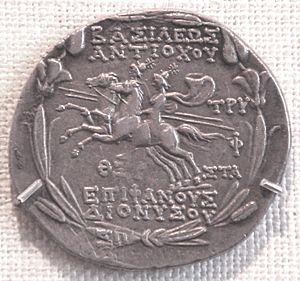Castor and Pollux facts for kids
Castor and Pollux were famous twin brothers in ancient Greek and Roman mythology. They are often called the Dioscuri, which means "sons of Zeus" in Greek. Their mother was Leda, and they had twin sisters, Helen of Troy and Clytemnestra.
In the myths, Castor and Pollux had the same mother but different fathers. This meant Pollux was immortal (he could not die), while Castor was mortal (he could die). When Castor was killed, Pollux was very sad. He asked Zeus, the king of the gods, to let him share his own immortality with his brother. Zeus agreed, and to keep them together forever, they were transformed into the Gemini constellation in the night sky. Castor and Pollux were seen as protectors of sailors. They sometimes appeared to sailors as St. Elmo's fire, a glowing light seen on ships during storms.
Different Stories of the Twins
Ancient Greek writers told several versions of the story of Castor and Pollux. For example, the famous poet Homer first wrote about them as regular people who died. But in another one of his stories, the Odyssey, he said they were alive even after death. He described them as having "honour equal to gods," living on alternate days because Zeus helped them.
In both Homer's Odyssey and in stories by Hesiod, another ancient writer, Castor and Pollux were described as the sons of Tyndareus and Leda. However, in stories by Pindar, Pollux was the son of Zeus, while Castor was the son of the mortal Tyndareus. This idea of having one mortal and one immortal parent was also seen in the stories of other heroes like Hercules and Theseus.
How They Were Shown in Art

Castor and Pollux were almost always shown with horses in art and literature. This is similar to other twin gods in different mythologies, like the Ashvins from ancient India, who also loved horses. Because they were skilled horsemen, they were very popular with the Roman equites (knights) and cavalry (soldiers on horseback). Every year on July 15, which was the feast day of the Dioskouroi, about 1,800 Roman knights would parade through the streets of Rome. Each rider wore their full military uniform and any awards they had earned.
The twins were often shown as horsemen wearing helmets and carrying spears. On special votive reliefs (carved stone offerings), they were shown with symbols that represented them as twins. These symbols included two upright pieces of wood connected by cross-beams, a pair of amphorae (jars), two shields, or even two snakes. They were also often shown wearing felt caps, sometimes with stars above them. These caps, called pilos (πῖλος), were thought to be parts of the egg from which they hatched.
Images for kids
-
Fragmentary remains of the Temple of Castor and Pollux in Rome.
-
Etruscan inscription to the Dioskouroi as "sons of Zeus" at the bottom of an Attic red-figure kylix (c. 515–510 BC)
See also
 In Spanish: Dioscuros para niños
In Spanish: Dioscuros para niños






